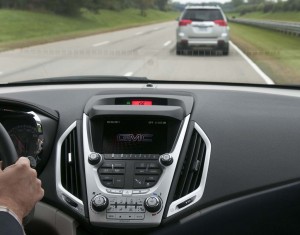
Vehicle-to-vehicle communication systems that make driving safer were named as a breakthrough technology by MIT.
MIT Technology Review named Vehicle-to-vehicle communication, a much-discussed idea in the auto industry, one of the 10 Breakthrough Technologies for 2015.
Each year, MIT and Technology identify technologies from the past year that solve difficult problems or create powerful new ways of using technology to make the world better.
The V2V communications technology allows vehicles to communicate with other vehicles and is considered by advocates as a solution to reducing the slow traffic on increasingly crowded roads and freeways and to cutting traffic injuries and fatalities.
The infrastructure has been developed in some places such as Singapore, which is using it to reduce traffic and divert commuters to mass transit to reduce travel times when the city-state’s road network is overcrowded.
General Motors Co. is one of the automakers that has emerged as a supporter of V2V technology and the first automaker to commit to bringing the technology to market.
The 2017 Cadillac CTS will offer the technology that could mitigate many traffic collisions and reduce traffic congestion by sending and receiving basic safety information, such as location, speed and direction of travel between vehicles approaching each other. It will warn drivers and can supplement active safety features, such as forward collision warning, already available on many cars, according to GM executives.
Bruce Bezlowski, managing director of the University of Michigan’s Transportation automotive futures project, noted at recent symposium on U-M’s Ann Arbor campus that other automakers and their suppliers are not convinced local and state governments and the federal government will actually commit the kind of financial resources need to make the V2V systems work effectively.
“They don’t believe they are going to invest in the infrastructure,” he said.
V2V communications system have been a topic of intense study at U-M over the past couple of years so Bezlowski has a unique vantage point from which to discuss the topic.
The U.S. Department of Transportation is financing a major V2V experiment around Ann Arbor but it still covers only a relatively small portion of the city. U-M and UMTRI have also developed a V2V simulation area on the University’s North Campus in Ann Arbor.
(Cadillac to offer nearly autonomous car by 2017. For more, Click Here.)
Other automakers, such as Audi and Mercedes-Benz as well as Silicon Valley companies such as Google and Apple are investing in autonomous driving vehicles, which are capable of steering their own course with the need of help from other vehicles or the infrastructure.
Autonomous cars would have the technology on board to utilize the V2V structure in it was in place, he added.
(Click Here for details about the potential federal rules for V2V communications.)
Supporters of V2V have been campaigning to broaden the financing of the kind of infrastructure required to support motorways that wouldn’t require stop lights and re-route traffic to less congested streets.
A bill sponsored by Rep. Candace Miller (R-Michigan) that would permit the use of money from the Surface Transportation Bill, the main federal subsidy for highway repair and construction, for “vehicle to infrastructure.” Money for the Surface Transportation Bill comes from the federal gasoline tax, which is already used to items such as mass transit that have gained only modest support after some ferocious political horse trading.
(To see more about why recall numbers are expected to remain high, Click Here.)
Miller’s bill is supported by the Intelligent Transportation Society, the umbrella organization of government officials responsible for transport, academic researchers and representative from industry that support the idea of transportation systems designed to work around problems of gridlock.

The paid liars are going to cash in big time on this tech when people are injured or death occurs.
As you would expect, an unscrupulous politician wants to raid the funds targeted to repair the horrendous roads we suffer with in the U.S., so the politician can pander to new tech. Obviously if the tech is that important and valuable, private investors would be lined up.